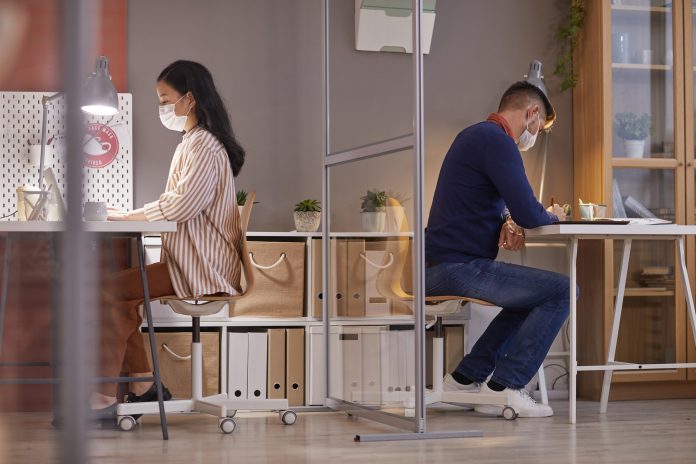Kieron Murphy, Chief Customer Officer at Matrix Booking, explores the concept of smart sharing, explaining that public bodies seek a digitally assisted transition towards cross-organisation working
The UK’s public sector is getting smarter, reaping the benefits of the more flexible, hybrid and reimagined working revolution that is so often discussed in commercial realms. The difference is public sector institutions have been riding this wave for over five years and the business world is only now catching up.
The UK is currently spearheading a trend where cross- organisational sharing of workspaces in the public sector is becoming more and more frequent. Even more interestingly, due to the sensitive nature of the work being carried out, the sector may even serve as an example of how all entities should be re-evaluating their real estate moving forward.
Cross-organisation sharing of workspaces is a natural fit for the private sector given the constant pressure to improve efficiency and reduce costs. Finding ways to work smarter by facilitating inter-organisational cooperation is essential in future-proofing this sector. There has been a general recognition that creating more linear, open and collaborative spaces is ideal when everyone is already working towards the same ultimate goals.
Breaking down walls and physically merging siloes has the potential to drive knowledge sharing, quicken problem solving, and ignite out-of-the-box ideas. It is also a natural segue to the workspace being a primarily collaborative space, while ‘focus’ tasks take place in isolation, in home offices.
But there is also the added challenge of meeting high data security requirements. The fabric of these institutions means that not everything being worked on or discussed can become the same communal task across the wider organisation. There is more of a need for privacy, security and confidentiality. Addressing the security aspect further, the nature of the data being dealt with means that inter-organisational collaboration and flexible-working fall under greater scrutiny.
In this regard, the transition, more than most, is tech- assisted.
A more viable dynamic
Naturally, however, like everything else over the past two years, the transition and trend have also been COVID-assisted.
Firstly, with the removal of side-by-side desks as a result of the pandemic, came a more natural creation of booths, dividers or protection from other workers – a transition that offset the need for different offices or different floors in their entirety. By consolidating departments and reducing overheads around the location itself, while maintaining privacy and required siloes, the organisation can save space and money while still harnessing both sides of the focus- collaboration coin.
Secondly, while the work being carried out is more sensitive and less conducive to at-home working, the pandemic did still inevitably force government entities and public providers into that dynamic – complete with all devices, systems and solutions to ensure employees were still working securely from their kitchens and sofas.
As a result, the capacity required across entire buildings has substantially reduced and the possibility of safer and viable shared working has come into play.
Data-driven first steps
Upon this more favourable landscape for shared workspaces in the public sector, a catalyst for digital intervention is also being seen. With the sector being more nascent with the trend, yet more protective over the work being conducted, public bodies have sought a more structured and digitally guided transition.
Our data confirms this shift, with millions of bookings made by civil servants using our dedicated workplace tools every month.
“The UK is currently spearheading a trend where cross- organisational sharing of workspaces in the public sector is becoming more and more frequent. Even more interestingly, due to the sensitive nature of the work being carried out, the sector may even serve as an example of how all entities should be re-evaluating their real estate moving forward.”
These may relate to workflow management tools to provide flexibility and clarity around what spaces are available, and when. They include security solutions to ensure that anyone booking time in-office is who they say they are, before entering under proper protocols. They address meeting room and boardroom booking tools to add a layer of additional security for high-level meetings, training or presentations. Or they could refer to visitor management systems to guarantee room availability and attendee verification in this new-look space.
Most importantly, these public and governmental organisations are leveraging highly complex sensors and resultant data across all these parameters to audit transition success, and to better inform their next steps. Cross-organisational working and shared spaces are still relatively new concepts, and the sector is working harder than most to ensure these first forays aren’t being taken blindly, or as a kneejerk reaction to the wider working world.
Take note, private sector
It may seem counter to stereotypes that it is our governments, our utilities or our civil servants that are leading the digital transformation of office real estate. And while it would be a little exaggerative to suggest they are; in the UK especially, the use of innovation to guide hybrid working transitions is providing numerous, successful case studies for commercial players to heed.
For public sector workers themselves, the satisfaction of more flexible operations and greater collaboration are now not only mirroring the private realm, but maybe even surpassing it; given how stringent the sector was before.
To indulge cloud-first, SaaS-driven innovations en route to a more flexible, collaborative and shared physical presence is a step-change for this segment of work, make no mistake. And, as such, it may even be a lesson for its commercial counterparts to follow as they carry out their own workspace transformations.











